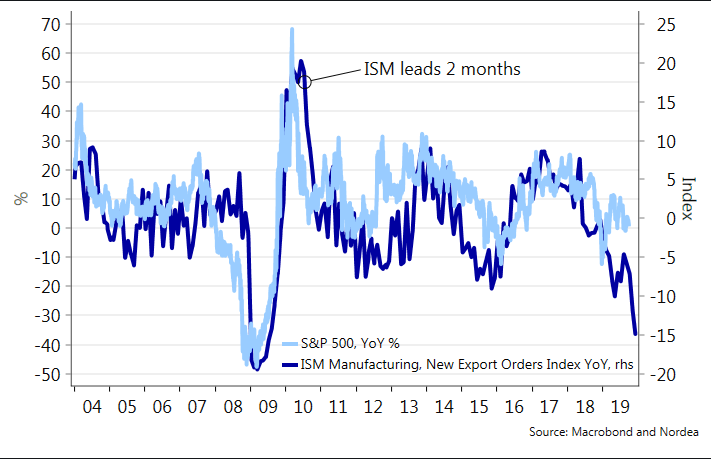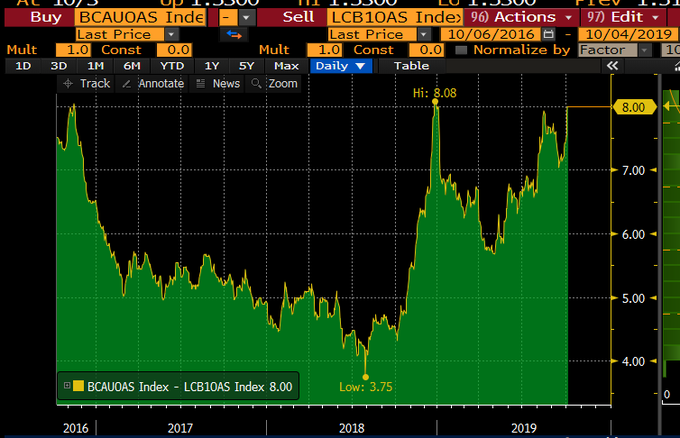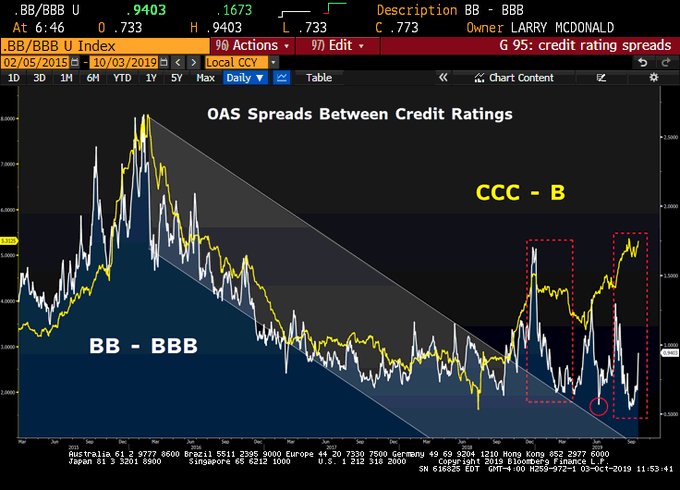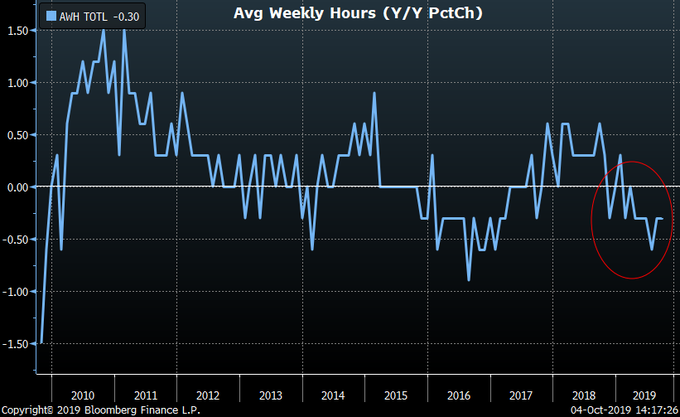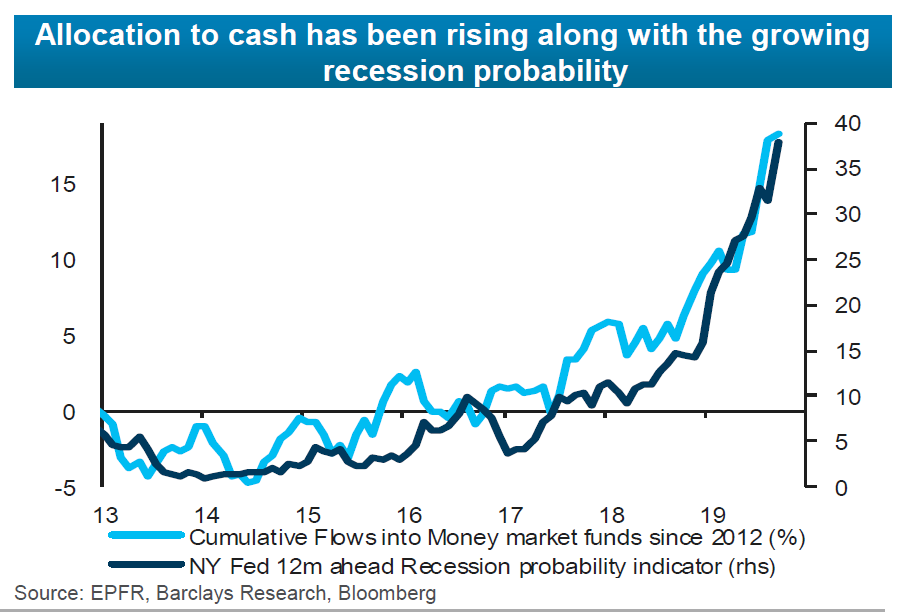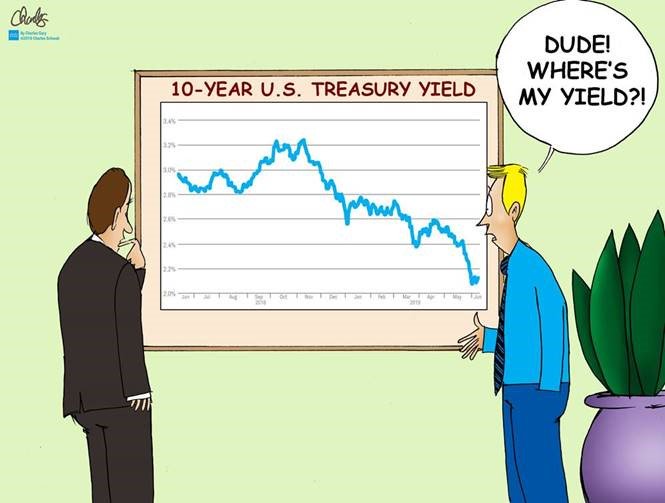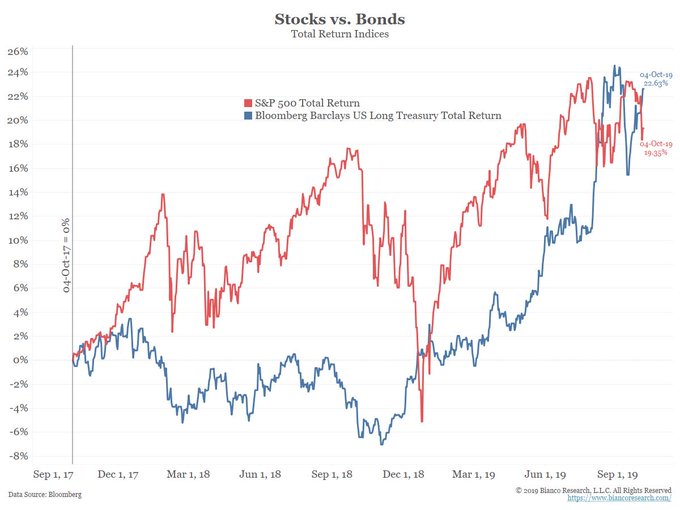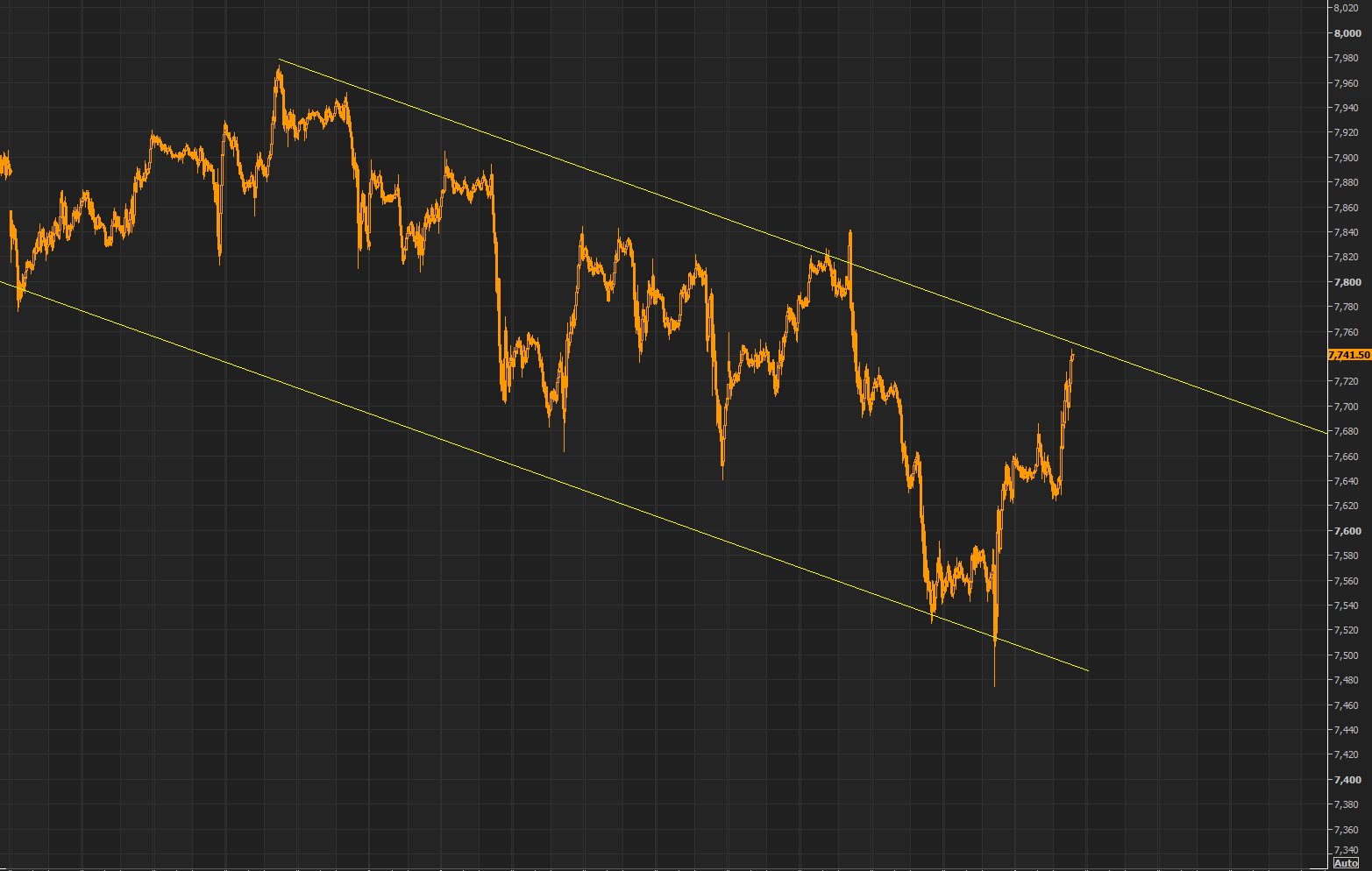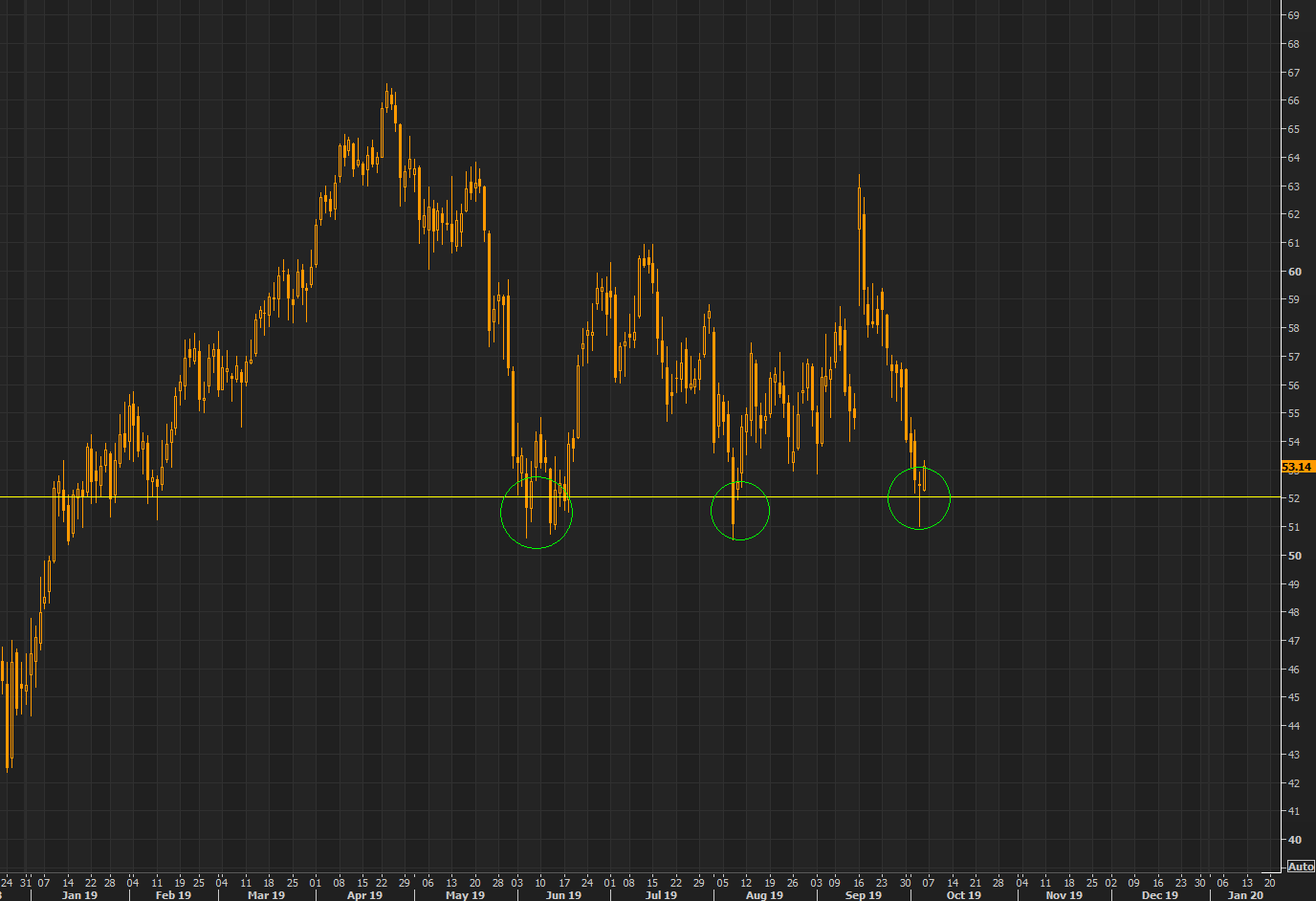Summary – A top-down review of interesting calls and comments made last week in Treasuries, monetary policy, economics, stocks, bonds & commodities. TAC is our acronym for Tweets, Articles, & Clips – our basic inputs for this article.
Editor’s Note: In this series of articles, we include important or interesting Tweets, Articles, Video Clips with our comments. This is an article that expresses our personal opinions about comments made on Television, Tweeter, and in Print. It is NOT intended to provide any investment advice of any type whatsoever. No one should base any investing decisions or conclusions based on anything written in or inferred from this article. Macro Viewpoints & its affiliates expressly disclaim all liability in respect to actions taken based on any or all of the information in this article. Investing is a serious matter and all investment decisions should only be taken after a detailed discussion with your investment advisor and should be subject to your objectives, suitability requirements and risk tolerance.
1.Volatility Returns Or Seasonal Bottom Forming?
We have been told that yield curve inversion & Treasury Bond volatility are precursors for stock volatility. We all saw one outbreak of volatility from Tuesday 10:00 am to about Thursday 10:30 am this week. Those 48 hours saw a fast & furious fall in stocks by about 1200 points with VIX ramping up. Then within about 30 minutes of Services ISM coming in weak but above 50 on Thursday, the turmoil subsided. The Dow climbed over 470 points to close up by 122 points. Then came Friday’s soft or rate-cut-positive but non-recessionary NFP number of 135,000.
So fears of Slowdilocks turned to relief of Goldilocks & once again Pangloss returned as the oracle of markets. So much so that Friday afternoon action resembled a melt up with Dow up 372 points with Treasuries up as well.
As CNBC’s Bob Pisani kept repeating on Friday afternoon, the 1200 point decline from Tuesday to Thursday morning was followed by a 900 point rally from Thursday morning to Friday afternoon. The big question is whether this was just a tantrum that passed or is this a precursor of a bigger storm?
One opinion was expressed on Thursday morning by the Marco team at Nordea relayed by The Market Ear:
- “So far, equities in 2019 have been saved by falling interest rates and rising valuation multiples. Macro trends have deteriorated further, however, creating a substantial macro/equity market divide. There are still plenty of macro risks at play and several possibilities for black swan or fat tail events. We are also entering a period when we expect an earnings recession to take hold, which has historically meant falling equity prices. So, even though we see some indicators of an improved business cycle later in 2020, we find that the overall risk/reward remains unattractive. We thus revise our roadmap somewhat and await a more substantial shift in consensus expectations.”
A different opinion came on Thursday from Tom McClellan & his article AAII Survey Shows Sentiment Washout.
- This week’s 21% reading [percent of Bulls] is among the lowest of the last several years, and most of the time a very low reading like this will be a good marker of a price bottom. That does not always work, however, as the episode in mid-2015 demonstrates.
- In this case, readings [percent of Bears] of around 40% or higher make for pretty good bottom indications, although there can be exceptions as we saw in March 2017 with an anomalous 46% bearish reading which did not bring a bottom.
Then he adds the element of time to the Bulls-Bears spread:
- There is one additional way I like to look at these numbers, which is to see very sudden shift in the Bull-Bear Spread. I do that with a 2-week change, as shown in this next chart:”
- “I have drawn a dashed line at the -0.2 level, which means minus 20 percentage points, and readings down below there tend to mark pretty good bottom indications for prices. …. Right on time for a nice seasonal bottom.”
Is there any thing else? We don’t mean rate cuts or blunt instruments like that. How about a quietly simple operation to add liquidity? Remember the great Rumsfeld dictum – never let a crisis, in this case spelled as Repo, go to waste.
- Jim Bianco@biancoresearch – Yrs of piling on rules on reserve use and not understanding the impact of QE/QT resulted in a repo that is too small for the Govt Sec market. Now at a 40 yr low. So 1) cut regs 2) Restart QE (but call it something else). Until then, they will need to be in the market everyday.
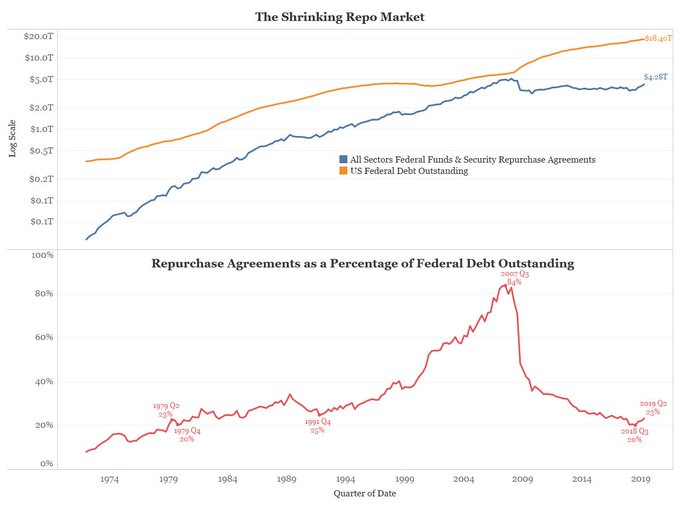 The above is so indirect, isn’t it? Simple minds like ours prefer simpler pictures:
The above is so indirect, isn’t it? Simple minds like ours prefer simpler pictures:
- Robert BurgessVerified account @BobOnMarkets – QE or not QE? Here’s what the Fed’s balance sheet assets look like after unclogging the repo market. Has expanded by $180 billion in a few weeks to $3.946 trillion
We do think the steep fall of 1200 points in 48 hours has reminded the dissenters at the Fed of Q4 2018. Boston Fed’s Rosengren was not as adamant on Friday as he was right after his dissent at the last FOMC meeting. Hopefully they remember that Q4 2018 turmoil during the upcoming FOMC meeting.
Next week we get back to the US-China “will they or won’t they” game. Then you have the ECB on October 20 & the FOMC on October 30. It may be an interesting month but we would not be surprised to see new all-time highs in the S&P 500 in October, before the tremors underground in credit possibly & unfortunately bubble up if the Fed doesn’t smooth them out.
- Lisa Abramowicz@lisaabramowicz1 – Credit markets are very bifurcated right now, w/investors all crowding into safer securities while often shunning the riskiest junk bonds. They’re earning a near record low yield of 3.1% to own BBB bonds & the spreads on those vs CCC bonds are now close to the highest since 2016
How about a simple description for simple minds?
- The Bear Traps Report@BearTrapsReport – The Important point here is that the weakest areas of credit were telling you that recession risk was rising. Now the ‘BB Safe-Haven’ beginning to get hit…
Get us those new all-time highs before the above twain meets or come close to meeting.
2. NFP, Consumer & Inflation
The 135,000 NFP report was not strong & that was the bullish thing about it, as the stock market told us. But how lukewarm was it?
- Richard Bernstein@RBAdvisors – Some seem excited regarding what is a 2-decimal point bounce in yr/yr #job creation (1.42% growth to 1.44%…whoopee!!) , but the 6-month momentum remains at a cycle low.
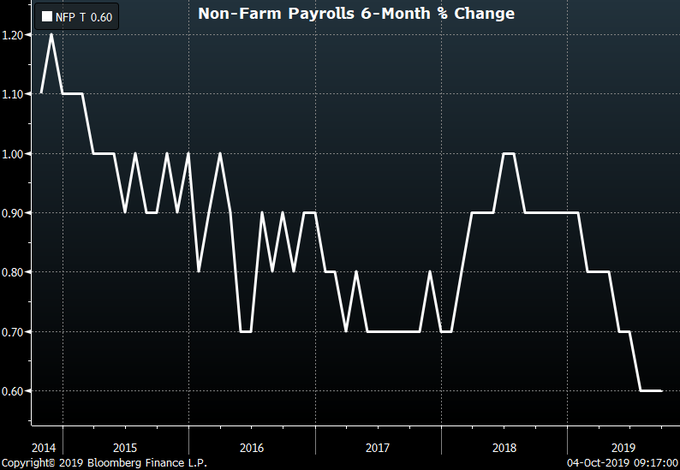 David Rosenberg pointed out that the employment report failed to “show any growth in personal income“. Why? A guest from JP Morgan said on CNBC – “any body can get a job but it’s much harder getting a raise“. Rosenberg’s ex-colleague showed us a better reason, a numerical reason:
David Rosenberg pointed out that the employment report failed to “show any growth in personal income“. Why? A guest from JP Morgan said on CNBC – “any body can get a job but it’s much harder getting a raise“. Rosenberg’s ex-colleague showed us a better reason, a numerical reason:
- Richard Bernstein@RBAdvisors – Not much chatter about a continued worrisome aspect of today’s #employment report. Hours worked continues to be trimmed.
We do recall that when Rosenberg & Bernstein agree, not listening to them proves expensive. But no R-word yet in our article? Fear not. Here is a chart relayed by The Market Ear:
- “nice correlation between increased recession risk and increase in cash levels“
Guess what all this is doing to US Inflation expectations?
- Charlie Bilello@charliebilello – US Inflation Expectations (10-yr breakeven) fall to lowest levels since September 2016: 1.48%. Fed has cover to keep cutting rates.
3. Treasury Rates
Look what Kathy Jones, the smart & sensible fixed income strategist at Schwab, tweeted:
- Kathy JonesVerified account @KathyJones– How a lot of financial advisers feel this year.
What would Jim Bianco say to them?
- Jim Bianco@biancoresearch – They should be thanking god they get 2%. In 2019 this is a really high yield, so grab it before it goes away … and enjoy the TOTAL RETURNS!
Something big happened this week in Treasuries. Japan’s bond market suffered a shock with an almost failing 10-year JGB auction. And, as we recall, Treasury 10-year & 30-year rates rose by 7-8 bps on Tuesday morning. Then the Manufacturing ISM number hit at 10:00 am & Treasury rates fell hard & never looked back the rest of the week.
Also the German Bund rates closed up or unchanged on the week while Treasury yields fell hard. The German 2-year yield rose by 1 bps to minus 75 bps while the US 2-year yield fell by a stunning 24 bps on the week (& the 5-year yield fell by 22 bps). The German 30-year yield closed UP 1.6 bps while the 30-year Treasury yield fell by 12 bps on the week to 2.01%.
The real message is that the US economy is now slowing down & the Fed is awfully out of step & about to close the gap in rates. A big tell is that the US 2-year yield closed on Thursday at a new all-time low of 1.39%. No wonder Jim Bianco thinks the US 10-year yield is headed to 1% or below:
But the next ECB meeting on October 20 can create a hurdle. Recall that the fast sell-off in US Treasuries began the day of the last ECB meeting because of the possibility of a fiscal stimulus in Europe. Now Christine Lagarde is the new ECB chairwoman & that creates an uncertainty.
On the other hand, the chances of a fiscal action in US seem completely off the table given the political combat in Washington DC. So what happens to the Treasury-Bund spread in the next 3-4 weeks?
4. Stocks & will the worst become not so bad?
Support & Resistance levels we thought we understood. But what sense do we make of this week? First support at 2940 was decisively broken in price & so 2940 should have been resistance for the rally. But that resistance proved as feeble as the support on the downside.
So now what? The Channel?
- The Market Ear – NASDAQ – back to trend channel highs – 30 min chart since mid September.
Carter Worth of CNBC Options Action went negative on Transports on Friday. And the sector-antonym (if the term or the concept even exists) of Transports is Oil, right? So just as the chart of Transports looks to head down, as Mr. Worth explained, the chart of Oil suggests at least the possibility of a bounce. Judge for yourselves:
- The Market Ear – Oil – third time is the charm? Looks like everybody has been washed out during the past weeks. Time for a bounce here?
Netflix is also trying to break out of a downtrend. But what could remind us of Netflix when talking about Oil? Simple – the oil pipeline from Gwadar port in Balochistan (near the Iran border), the revolt of the Balochis against Napaki rule & the deadly games between the Taleban (now expanding into Balochistan from FATA) & their backers in the Napak ISI-Army AND the new Netflix original series named the Bard of Blood about the deadly games between all these groups.
But before you get into Baloch-PushtuniTaleban-NapakISI & Indian RAW game, we highly recommend watching the informative clip below on FATA (Federally Administered Tribal Areas). At least that will lend some insight into why the Taleban have no choice but to wage war. After all, their war in FATA first began in 1893 against the British. The British left, the Russian came & went. America came in 1979 in one role, left in 1989 & then came back in 2001 in the opposite role & is now trying to leave.
When America leaves, then we will have a game between NaPakistan, India & with China trying to hold on to their biggest & most critical infrastructure project – the corridor from Gwadar in Balochistan, across Balochistan to Quetta in Napak-occupied Pushtunistan to NaPakistani Punjab into Gilgit in Napaki-Occupied Kashmir into Kashgar in Xinjiang where China is holding over a million Muslim Uighurs in re-education camps.
 (careful – this is a Napaki map that shows Balochistan, Quetta & the corridor)
(careful – this is a Napaki map that shows Balochistan, Quetta & the corridor)
Clearly Chinese control of a strategic port like Gwadar at the opening of the Persian Gulf is not in American interests. Today the US role in Balochistan is still limited given the need for Napaki help in Afghanistan. But after the US leaves Afghanistan, will Balochistan become more interesting for America? We think so.
By the way, the Bard of Blood ends with the team of 3 Indian Agents delivering a big Talebani Mullah dead to an American humanitarian NGO in Balochistan (so US can take full credit for the kill) & in exchange getting airlifted out of Balochistan in an American helicopter that had landed ostensibly to deliver humanitarian supplies.
And double by the way, Netflix is building a real fan base for such original series in India that are different from Bollywood type action films.
Send your feedback to editor@macroviewpoints.com Or @MacroViewpoints on Twitter
